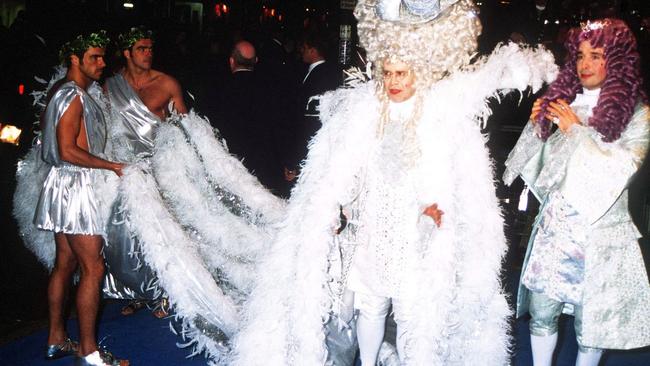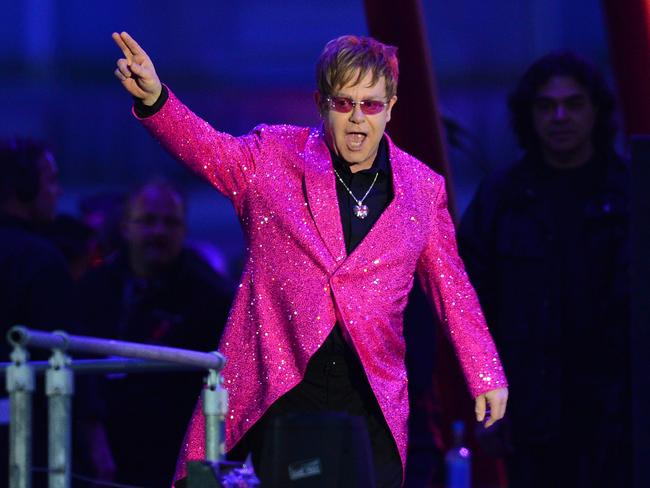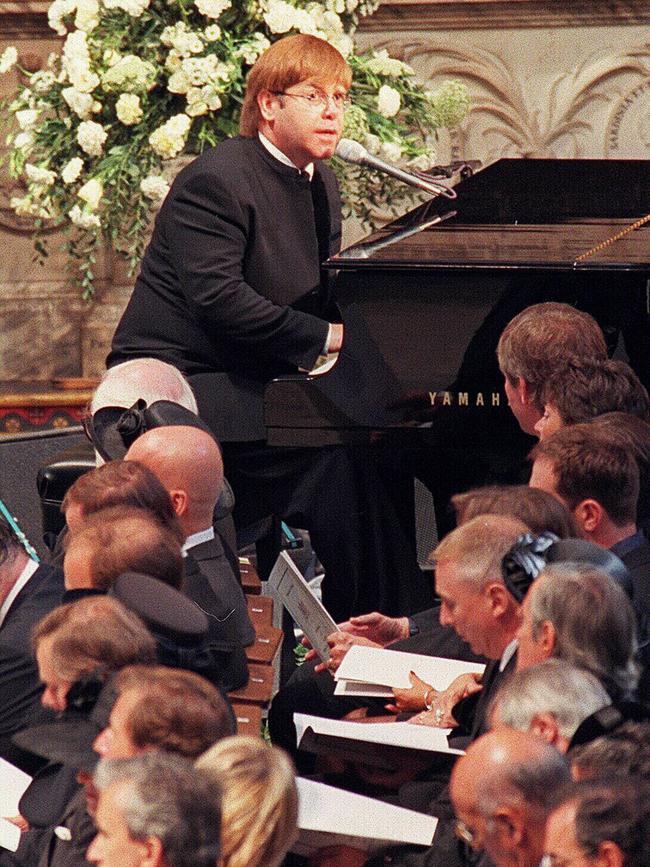Elton John’s wild times with the royals
In Me, Elton John laments being an outsider but revels in his links to the Firm.

In an act of quite royal audaciousness, Elton John uses his new autobiography, Me, to play the humble outsider from Pinner, astounded to hobnob with the Queen. As John tells it, he is a fringe figure on the side of the mavericks and misfits within “the Firm”, namely Princess Diana and, latterly, her son Prince Harry.
When he meets Diana at Prince Andrew’s 21st birthday party at Windsor Castle in 1981, they bond over the absurdity of the event. This is a 21st party for 500 people, including the prime minister, Margaret Thatcher, at which everyone is so scared of the Queen that the music is turned as low as it can go. The sound of shoes scraping on the dancefloor muffles the tune. John and Diana are on the floor first. Although he is 14 years her senior he cuts a sympathetic, similarly insecure, figure; they break into a silly dance that mocks and relieves the tension.
For Diana, and later her son, John is confidant, matchmaker — he reveals a quite surreal dinner party at which Sylvester Stallone and Richard Gere lock antlers over the chance to seduce Diana — and mischief-maker.
The less rock ’n’ roll but more fascinating truth is that John is no rebel. He occupies an unprecedented role at the heart of the British royal family. The pop star has spent the past half-century befriending four generations of Windsors, mostly women, from the Queen Mother to Princess Margaret, then Princess Diana, then her sons, Prince William and Prince Harry. At 72, John is about the same age as Prince Charles and has a son the same age as Charles’s grandson, Prince George.
A few years after his relationship with the royals began in the early 1970s John even moved into the Woodside estate. This grand residence was built at the edge of Windsor Great Park for Henry VIII’s surgeon so the king could summon his courtier immediately by flying an emergency flag from the roof of the castle.
That night of Andrew’s 21st party, Diana may have felt like Cinderella, but John was far from an outsider — he was the Queen’s next-door neighbour.
Bernie Taupin, John’s songwriting partner, recalls going to dinner at John’s house and being startled to find himself sitting next to the Queen Mother. “While we were out in the garden we could see the tower of Windsor Castle,” Taupin said later, “where the flag was flying. ‘Oh,’ the Queen Mother said. ‘My daughter’s at home.’ ”

John is more than a courtier, more than a minstrel or a bejewelled Sir Walter Raleigh. He is more a shadow or alternative queen; for instance, he revealed this summer that he is benefactor to Prince Harry and his wife, his new neighbours in Windsor, funding their private jet flights to his residence in the south of France. While he is rock ’n’ roll royalty, he occupies the opposite end of the spectrum to the Sex Pistols.
He has made no secret of his royal ambitions. One of the most famous images of him is at his 50th birthday party: like a mirror image of Prince Andrew’s 21st, with himself cast as the monarch.
Again, 500 guests were invited, with John wearing a towering silver wig and a 15ft train carried by two half-naked, bronzed footmen, and looking as if he had been blasted by a sequin cannon. It was like a drag-queen mash-up of Louis XIV and Marie Antoinette. It is no coincidence that the documentary about John that his husband, David Furnish, made is called Tantrums and Tiaras. What could be more royal than a man with such flair for pomp, so many scandals about sex and excess attached to him, such a tortured relationship with fame and thinning hair?
It is slightly odd, then, the tone he takes in his autobiography, describing that 21st. “Because the Queen was there, and no one wanted to cause any offence to the royal sensibilities, the disco was turned down about as low as you could get without switching it off altogether,” he writes. “You could literally hear your feet moving around on the floor over the music.
“Then the Queen appeared, carrying her handbag. She walked over and asked if she could join us. So now I was trying to dance as inaudibly as possible with Princess Anne and the Queen — still holding her handbag — while what appeared to be the world’s quietest disco (went on) … I tried my best to come up with a facial expression that suggested this was a perfectly normal state of affairs.”
Diana was then 19 and a month away from marrying Charles. She and John end up “hooting at the disco’s feebleness” while pretending to dance the charleston.
He skims over his many social occasions with the royals for more anecdotes. “In private”, he says grandly, the Queen is “hilarious”. Princess Alexandra asked him if he did coke before performing.
“At another party,” John writes, he sees the Queen mock-slap Viscount Linley across the face, “saying, ‘Don’t’ — SLAP — ‘argue’ — SLAP — ‘with’ — SLAP — ‘me’ — SLAP — ‘I’ — SLAP — ‘am’ — SLAP — ‘THE QUEEN!’.” The Queen ends this high-camp performance, straight from the RuPaul playbook, with a wink to John, who appears to be taking mental notes. But, he says, after all these encounters, “there would inevitably come a moment where I’d find myself thinking: ‘This is just bizarre. I’m a musician from a council house on Pinner Road — what am I doing here?’.”
The trouble is that, while John’s repeated presence was bizarre, it was also “a perfectly normal state of affairs”. John was recruited for the royal family by Princess Margaret nearly a decade earlier. She and the Queen Mother were early adopters of his music and he loved their attention. They may have also felt quite comfortable with his then-closeted homosexuality.
There is a long tradition of Buckingham Palace employing gay staff. There is an apocryphal story that the Queen Mother, who had a number of gay footmen, grew impatient with their delay in bringing her gin and tonic. “When one of you old queens has finished, this old queen would like a drink,” she is alleged to have said.
John, in recent years, likes to joke about being an “old queen” himself.
When asked why he played so few festivals, John once replied, with true insider knowledge: “I’m too scared that people will throw things at me. I’m like the Queen Mother.”
Princess Margaret was photographed backstage at John’s concerts from the early 70s and the pair socialised together. Taupin, again, was surprised at their easy intimacy. In the early 70s, after a concert, Margaret invited the band back to Kensington Palace, stretching protocol to its limits. On that occasion Taupin split his trousers and had to wear Lord Snowdon’s dressing-gown while a lady-in-waiting repaired them. “The whole thing was very odd,” Taupin recalls.
In that kind of bohemian spirit John hosted a dinner party for Diana in the early 90s, when she was separated from Charles. John says that she was “the best dinner party guest, incredibly indiscreet, a real gossip”.
The guests that night were something like a fantasy dinner party game, including George Michael, Gere and Stallone.
“The most peculiar scene developed. Straight away, Richard Gere and Diana seemed very taken with each other … They ended up sitting in front of the fireplace together, locked in rapt conversation.” Later, Stallone and Gere were found in the corridor, “squaring up to each other, apparently about to settle their differences over Diana by having a fistfight”. Stallone stormed off home. “I never would have come,” John recounts him saying, “if I’d known Prince f..kin’ Charming was gonna be here.” Then he added: “If I’d wanted her, I would’ve taken her!”
This story again casts Diana as Cinderella and John as some role rarely cast: uncle turned agony aunt, turned fairy godmother. John and Diana would fall out over her pulling out of participating in a charity book, but in July 1997 they reunited over the death of Gianni Versace. Diana lent him her support at the funeral.
“Although I feel I should point out,” John writes, “that the famous shot they got of her supposedly consoling me — where she’s leaning forward towards me, speaking, while I’m red-eyed and glazed with grief — is one moment in the service where she wasn’t doing anything of the sort.” She was in fact reaching for a mint. “The warm words of comfort coming from her lips at that exact moment were actually: ‘God, I’d love a Polo’.”
A few weeks later she was killed, and John spent a night in his Windsor home, rehearsing a new version of his classic song Candle in the Wind to sing at her funeral. The Queen would later knight him for his services, public and private, and he would kneel before the woman he jived with that night in 1981.

Last year John was back, performing at Windsor at the private reception after the wedding of Prince Harry.
It was nearly four decades since he had tripped over from Woodside to meet Prince Harry’s mother, a lonely 19-year-old on the quiet dancefloor.
“Maybe stuff like that happened to her all the time and she was used to it,” John mused in his book after their strange dinner party with Princess Diana, Stallone and Gere. Maybe the same goes for him.
The Times
This weekend in Review, Will Hodgkinson gives his verdict on Elton John’s new book.



To join the conversation, please log in. Don't have an account? Register
Join the conversation, you are commenting as Logout